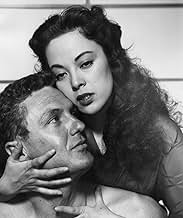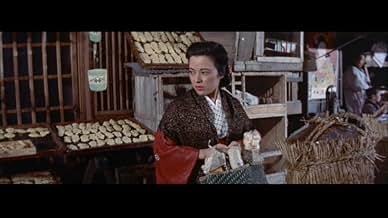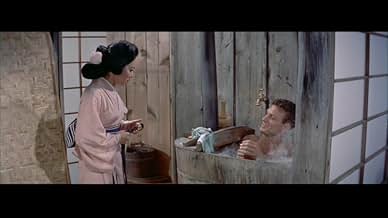IMDb रेटिंग
6.8/10
4.4 हज़ार
आपकी रेटिंग
अपनी भाषा में प्लॉट जोड़ेंPlanted in a Tokyo crime syndicate, a U.S. Army Investigator attempts to probe the coinciding death of a fellow Army official.Planted in a Tokyo crime syndicate, a U.S. Army Investigator attempts to probe the coinciding death of a fellow Army official.Planted in a Tokyo crime syndicate, a U.S. Army Investigator attempts to probe the coinciding death of a fellow Army official.
Clifford Arashiro
- Policeman
- (बिना क्रेडिट के)
Sandy Azeka
- Charlie's Girl at Party
- (बिना क्रेडिट के)
Harry Carey Jr.
- John
- (बिना क्रेडिट के)
Barry Coe
- Captain Hanson's Aide
- (बिना क्रेडिट के)
John Doucette
- Skipper
- (बिना क्रेडिट के)
Fuji
- Pachinko Manager
- (बिना क्रेडिट के)
Samuel Fuller
- Japanese policeman
- (बिना क्रेडिट के)
Peter Gray
- Willy
- (बिना क्रेडिट के)
फ़ीचर्ड समीक्षाएं
No need to recap the plot. The movie's one-third caper film, one-third romance, and one- third travelogue. Cult filmmaker Fuller tries to bring them together, but only partially succeeds, despite that colorful climax with the revolving globe and the rooftop view of Tokyo. Two of Fuller's usual concerns prevail here as elsewhere—culture clash and military organization.
Mariko and Eddie must work through their cultural differences before establishing a real relationship. Screenwriter Fuller spends a lot of time with this, maybe too much since it drags out the pacing. However, I suspect he was revealing a timely cultural glimpse to American audiences—remember this was less than a decade after the war and, generally, Americans knew very little about their new Cold War partners or traditional Japanese society.
Surprisingly, the robbery capers are dealt with only briefly and without the expected rising tension. In fact, Fuller seems more interested in the para- military discipline that defines the gang than in the robberies themselves, an aspect that produces more talk than action. Getting the great Robert Ryan (Sandy) as the gang's "5-star general" was the real casting coup since it's his fierceness that delivers the film's main impact. (In passing—Griff's {Mitchell} attachment to Sandy appears ambiguous enough to be interesting for the time.)
Frankly, I liked the travelogue parts best. Fuller does a good job working these into the story, while the scenes themselves of Japanese landmarks and street crowds are colorful as heck. Anyway, the movie's too uneven and diffuse to have real impact. Still, it does remain a visual treat despite the passing decades.
Mariko and Eddie must work through their cultural differences before establishing a real relationship. Screenwriter Fuller spends a lot of time with this, maybe too much since it drags out the pacing. However, I suspect he was revealing a timely cultural glimpse to American audiences—remember this was less than a decade after the war and, generally, Americans knew very little about their new Cold War partners or traditional Japanese society.
Surprisingly, the robbery capers are dealt with only briefly and without the expected rising tension. In fact, Fuller seems more interested in the para- military discipline that defines the gang than in the robberies themselves, an aspect that produces more talk than action. Getting the great Robert Ryan (Sandy) as the gang's "5-star general" was the real casting coup since it's his fierceness that delivers the film's main impact. (In passing—Griff's {Mitchell} attachment to Sandy appears ambiguous enough to be interesting for the time.)
Frankly, I liked the travelogue parts best. Fuller does a good job working these into the story, while the scenes themselves of Japanese landmarks and street crowds are colorful as heck. Anyway, the movie's too uneven and diffuse to have real impact. Still, it does remain a visual treat despite the passing decades.
At the end of the movie Robert Ryan doesn't fire more shots than he has ammunition. Look closely at the start of the pearl robbery, when the armourer is handing out weapons. Before he hands Ryan the P38 he gives him at least four spare magazines which Ryan clips to his belt.
In the mid-1950s, using the same screenwriter (Harry Kleiner) and cinematographer (Joe MacDonald) as in the original, the unpredictable Samuel Fuller remade 1948's The Street With No Name as House of Bamboo. For starters, he set in not in anonymous Center City but in post-war Japan -- the first American movie filmed there since the Second World War.
Even in color, Fuller's Tokyo has a grey, slummy look to it, punctuated only by women in blood-red kimonos shuffling through the Ginza. It's an open city where vice flourishes and where ex-G.I. Robert Ryan runs a string of pachinko parlors as a cover for a crime ring. Military investigators and Japanese police tumble to these activities when a U.S. guard dies during a train robbery. And thus enters Robert Stack, sent by the army to infiltrate the gang and solve the murder.
Fuller deals his cards from a deck shuffled differently from his predecessor, William Keighley (who directed Street). It's not clear at the outset who Stack is, keeping us off-balance for a while; there's also a cross-cultural love affair between Stack and Shirley Yamaguchi, the widow of a slain gang member -- Ryan's standing orders are to leave no wounded to tell tales. A twisted erotic charge links Ryan to his pursuer; hinted at in the original, here it deepens the dynamic of Ryan's jealous obsession with his "ichiban," or favorite lieutenants.(There are enough sliding rice-paper screens to fill all of Douglas Sirk's movies with metaphorical barriers, too.)
Far from merely capitalizing on the 50s fad for shooting on locations around the newly opened globe, Fuller seems to construct another metaphor -- for the Occupation of Japan as exploitative, parasitic. Luckily he doesn't press this too far, and House of Bamboo stands as an offbeat, deftly made crime thriller from late in the noir cycle -- albeit with Mount Fujiyama squatting serenely in the background.
Even in color, Fuller's Tokyo has a grey, slummy look to it, punctuated only by women in blood-red kimonos shuffling through the Ginza. It's an open city where vice flourishes and where ex-G.I. Robert Ryan runs a string of pachinko parlors as a cover for a crime ring. Military investigators and Japanese police tumble to these activities when a U.S. guard dies during a train robbery. And thus enters Robert Stack, sent by the army to infiltrate the gang and solve the murder.
Fuller deals his cards from a deck shuffled differently from his predecessor, William Keighley (who directed Street). It's not clear at the outset who Stack is, keeping us off-balance for a while; there's also a cross-cultural love affair between Stack and Shirley Yamaguchi, the widow of a slain gang member -- Ryan's standing orders are to leave no wounded to tell tales. A twisted erotic charge links Ryan to his pursuer; hinted at in the original, here it deepens the dynamic of Ryan's jealous obsession with his "ichiban," or favorite lieutenants.(There are enough sliding rice-paper screens to fill all of Douglas Sirk's movies with metaphorical barriers, too.)
Far from merely capitalizing on the 50s fad for shooting on locations around the newly opened globe, Fuller seems to construct another metaphor -- for the Occupation of Japan as exploitative, parasitic. Luckily he doesn't press this too far, and House of Bamboo stands as an offbeat, deftly made crime thriller from late in the noir cycle -- albeit with Mount Fujiyama squatting serenely in the background.
After World War II, Hollywood saw the Far East as simply a new background for familiar heroics... "House of Bamboo" was in fact a remake of a 1948 gangster melodrama called "The Street With No Name" with Richard Widmark...
An army cop (Robert Stack) with a charming widow (Shirley Yamaguchi) moves into undercover action in collaboration with the Japanese security authorities against Tokyo gangsters, and their leader Robert Ryan, an intellect mastermind racketeer, head of an impressive organization engaged in robberies, fraudulent businesses, and murder whose plots challenge the magnificent effort of the international police..
With fascinating Japanese locations and photographed in CinemaScope and Technicolor, the film depicted the wonders of Fujiyama, the extraordinary city of Tokyo and its back streets in water ways invoking mystery and intrigue...
An army cop (Robert Stack) with a charming widow (Shirley Yamaguchi) moves into undercover action in collaboration with the Japanese security authorities against Tokyo gangsters, and their leader Robert Ryan, an intellect mastermind racketeer, head of an impressive organization engaged in robberies, fraudulent businesses, and murder whose plots challenge the magnificent effort of the international police..
With fascinating Japanese locations and photographed in CinemaScope and Technicolor, the film depicted the wonders of Fujiyama, the extraordinary city of Tokyo and its back streets in water ways invoking mystery and intrigue...
I had fun through most of House of Bamboo, Samuel Fuller's second widescreen, first filmed out-of-the-US picture, even as I knew at the end it wasn't too special. It's got some memorable scenes with the two male leads, the kind of seemingly hard-boiled actors that probably wouldn't shake much if you hit them with some punches. And the whole plot line of the American crime ring in Tokyo in 1955 gives enough room for Fuller to realize some of the acting, camera and editing possibilities at his big-studio disposal. Robert Stack is in one of his best early parts as a would-be big crook undercover for the US army who infiltrates Robert Ryan's 'organization', where its tightly run to the point where Ryan's ready and willing to kill his own if wounded in the moment of crime. On top of this, Stack falls for a 'kimono' who was married to a late-member of the crime team. But will the deceiving remain?
The majority of the film works under the crime parts of the story, where in some scenes (maybe or maybe not in the new cinema-scope style) Fuller just keeps the camera on the scene without cutting. This room and space and time does create the right tension- and occasional humor- in the right spots. And Ryan is also up to task as the cold antagonist. Yet if there are parts of the film that are lesser than the bulk of it I'd say it would be with the 'Kimono' Mauriko, played by Shirley Yamaguchi. Her part in the story is mandatory to be sure, but it is just so-so in the writing and delivery, as far as such a formula would allow. And it is probably more of the writer's fault and even on Yamaguchi's end, arguably, than Fuller's. There are also some typical, dated bits of 'lost in translation' moments that may be part of the deal in making the very first Hollywood movie filmed entirely in Tokyo- they're 50/50 of doing the job for the entertaining parts of the picture.
Nonetheless, House of Bamboo is a more than decent example of what can be done with other material from one setting into another (both from a 40's noir, Street with No Name, and from US to Japan). There is also a sweet, if not greatly paced, climax in a wheel machine on a roof. It's gritty machismo with fun, with enough pure Fuller to suffice the studio standards.
The majority of the film works under the crime parts of the story, where in some scenes (maybe or maybe not in the new cinema-scope style) Fuller just keeps the camera on the scene without cutting. This room and space and time does create the right tension- and occasional humor- in the right spots. And Ryan is also up to task as the cold antagonist. Yet if there are parts of the film that are lesser than the bulk of it I'd say it would be with the 'Kimono' Mauriko, played by Shirley Yamaguchi. Her part in the story is mandatory to be sure, but it is just so-so in the writing and delivery, as far as such a formula would allow. And it is probably more of the writer's fault and even on Yamaguchi's end, arguably, than Fuller's. There are also some typical, dated bits of 'lost in translation' moments that may be part of the deal in making the very first Hollywood movie filmed entirely in Tokyo- they're 50/50 of doing the job for the entertaining parts of the picture.
Nonetheless, House of Bamboo is a more than decent example of what can be done with other material from one setting into another (both from a 40's noir, Street with No Name, and from US to Japan). There is also a sweet, if not greatly paced, climax in a wheel machine on a roof. It's gritty machismo with fun, with enough pure Fuller to suffice the studio standards.
क्या आपको पता है
- ट्रिवियाAccording to Robert Stack, Samuel Fuller told an actor to go down really low when he passed a 50-gallon drum. Without informing the actor, the director had a sharpshooter on a parallel who shot over the man's head and into the drum. After it blew up, the actor said, "Jesus Christ! Those were real bullets!" Fuller laconically replied, "Don't worry. He knew what he was doing."
- गूफ़Sandy fires an awful lot of shots from his pistol (which is a revolver) without ever appearing to reload it.
- भाव
Sandy Dawson: Who are you working for?
Eddie Kenner: [posing as Eddie Spanier] Spanier.
Sandy Dawson: Who's Spanier?
Eddie Kenner: Me.
Sandy Dawson: Who else you working for?
Eddie Kenner: Eddie.
- कनेक्शनEdited into Shock Corridor (1963)
टॉप पसंद
रेटिंग देने के लिए साइन-इन करें और वैयक्तिकृत सुझावों के लिए वॉचलिस्ट करें
- How long is House of Bamboo?Alexa द्वारा संचालित
विवरण
- रिलीज़ की तारीख़
- कंट्री ऑफ़ ओरिजिन
- भाषाएं
- इस रूप में भी जाना जाता है
- The Tokyo Story
- फ़िल्माने की जगहें
- टोक्यो, जापान(rooftop playground of the Matsuma department store)
- उत्पादन कंपनी
- IMDbPro पर और कंपनी क्रेडिट देखें
बॉक्स ऑफ़िस
- बजट
- $13,80,000(अनुमानित)
- चलने की अवधि
- 1 घं 42 मि(102 min)
- पक्ष अनुपात
- 2.55 : 1
इस पेज में योगदान दें
किसी बदलाव का सुझाव दें या अनुपलब्ध कॉन्टेंट जोड़ें



































